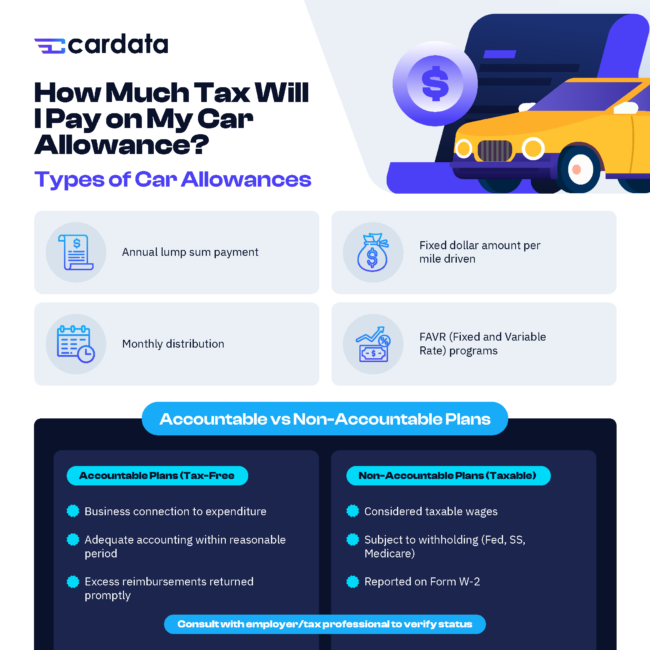Torben Robertson
12 mins
What is a Car Allowance?
Car allowances are payments made to employees who drive for work, to cover their business mileage expenses. They can be tax-free or taxed, and managed in-house or outsourced.

The Ultimate Guide to Car Allowance for 2025
In this guide we tell you everything you need to know about car allowances, including:
- why car allowances are sometimes taxed,
- how you can get a tax-free car allowance,
- what types of tax-free car allowances you can get—like the world’s most interesting car allowance, FAVR,
and more. So let’s dive right in.
What is a car allowance?
Car allowances are paid to employees who drive their personal car for work. They are replacements for company cars, where companies own vehicle fleets. We are not here discussing the personal use of company cars, but rather reimbursements for the business use of personal vehicles. That is what an allowance is at the end of the day.
There are two kinds of auto allowance in this world. One is tax-free and the other is taxed. Those are the most basic facts about car allowances. And at Cardata, it is our opinion that the tax-free ones are better. A large part of Cardata’s mission is to pay people tax-free car allowances.
We have some other names for these tax-free car allowances. Sometimes we call them mileage reimbursement programs, sometimes FAVR. But at the end of the day, what we want to do is make reimbursing drivers for their business mileage efficient and fair.
To start off, I’ll describe the taxable car allowances, the kind that Cardata doesn’t recommend.

Why are some car allowances taxed?
Taxable car allowances appear easy to administer. Companies pick them because it’s not hard to say, Here’s a monthly car allowance of $600 and use it for your work-related car expenses. Here it is together with your paycheck. Make sure you spend it on the right things because it’s the only one you’re going to get. And next month, I’ll give you $600 again. Many employers are having this basic conversation with their mobile team.
So then your driver sets off driving. Perhaps they are making sales calls, or going merchandising at a grocery store, or any other task mobile employees undertake. The driver doesn’t keep any expense reports—records of the expenses they incur while conducting business on your behalf. They take that $600 and most responsible drivers spend it on their vehicle expenses.
Now, the problem with this is that the IRS treats this car allowance, which you have designed to cover legitimate business expenses, as taxable income. And what that means is, your drivers are only taking home $400 per month. Now, this is a rounded figure. It really depends on the relevant driver’s personal income tax bracket, and even on payroll taxes like FICA.
But the point is this: oftentimes a driver’s car allowance—ostensibly something they need to fulfill their job function—is one third eaten away before they ever get to spend a dime. And it’s not just the driver who’s losing. Employers are paying, as I said, their taxes too, as much as 15% of the vehicle allowance.
If you want to read more about what taxes are applied to car allowances, read this:
www.cardata.co/blog/how-payroll-and-income-tax-affect-business-driving
But taxable car allowances are legitimate reimbursements. And the IRS obviously acknowledges this. So why would you pay tax on a car allowance? Well, as I said at the beginning, taxable car allowances of the sort I have been describing seem simple to administer by comparison.
Some tax-free car allowances are complex. That doesn’t mean (and we have to be candid here) that you can’t set up a tax-free car allowance in-house. It makes it turn-key to outsource a tax-free car allowance program—and, full disclosure, this is Cardata’s specialty—but there are simple versions of tax-free car allowances that you can run yourself at your company, or that you can pay yourself as an independent contractor. I’ll get into what those are specifically in a moment.
But first, tax-free car allowances have some basic commonalities.
What do all types of tax-free car allowance have in common?
- One, they are paid in some combination of fixed and variable reimbursements.
- And two, they require record keeping in order to be properly administered tax-free according to the IRS,
- All of these programs also reimburse employees who drive their personal vehicles for work. These programs obviously do not apply to fleet programs in which a company owns or leases all the vehicles, where these expenses are top line deductions.
Now that we have those commonalities established, let’s look at a few different car allowance programs.
Tax-free fixed rate vehicle allowances
The sort I was discussing earlier, taxable car allowances were presented as being one solid flat rate reimbursement. When I said you gave your driver $600 per month, I was describing a flat rate going out to them regardless of how many business miles they drive or how much fuel costs every month.
And you actually can reimburse your drivers tax-free in exactly the same way. The only difference is you have to add record keeping. Proper records involve mileage logs, which record not only the distance of trips, but also the business purposes of travel, and other relevant details. We call this kind of tax-free car allowance an accountable plan.
Now, once you’ve produced mileage expense reports, you need to perform a simple calculation, and compare the result to the IRS mileage rate.
Calculating tax on an accountable car allowance plan
The calculation is the only one you need: divide the drivers’ allowance by their monthly recorded mileage, and then that’s the number you’ll compare to the IRS rate. So if your driver received a $600 allowance and they drove a thousand miles, they would be getting $0.60 per mile. And the IRS standard rate at the time of writing is 62.5 cents per mile. So because your driver is below that threshold, you would know the driver’s entire allowance was able to be paid tax-free.
Now, if there had been a difference in the other direction and, having driven only 800 miles one month, the driver received $0.75 per mile, then those extra 12.5 cents would be taxed at the driver’s personal income tax rate, and at the company’s payroll tax rate. But only the delta is taxed.
And that’s one of the simplest kinds of tax-free reimbursement programs. And it is basically the same as the taxable car allowance that I was describing earlier. The only difference is the tax is now gone. All you need to do is track mileage, and write why your team went where they went. You can do that on a piece of paper, on an Excel spreadsheet, or with a premium software product; with hardware or with a mileage tracking app installed on drivers’ phones.
Infographic: what info you need to track for tax-free reimbursements

If you want to study Cardata’s version of this accountable plan, which we call Tax-Free Car Allowance, go here:
So where drivers were getting $400 before, now they’re getting $600, and you haven’t at all changed the car allowance amount. You can capture the savings yourselves, as a company, and return it to your ops, or give it to the drivers, or split it. Even if your accountable allowance is $500, that’s still $100 more than they were getting before, and your team has saved $200 overall. It’s a no-brainer.
Cents per Mile vehicle reimbursements
There are other kinds of tax-free car allowances, too. Some of them I have mentioned or alluded to already.
Just above, I mentioned the IRS standard mileage rate. You can also run an IRS standard rate program at your company, and this is a Cents per Mile (“CPM”) program.
This just means you calculate mileage for all your drivers and you multiply it by 62.5 cents (as of July 2022). And that’s everyone’s reimbursement.
This is a simple and fine program. And Cardata often helps our clients with implementing Cents per Mile programs. The IRS rule is that you can pay anything up to and including the IRS mileage rate tax-free. So you could offer a reimbursement expense of $0.50 per mile.
The only problem with these programs is that they don’t cover expenses incurred by an automobile that’s sitting on the lot.
If your driver only drives 100 miles on a CPM program, they only get $62.50 for the month. And if you’ve ever owned a car, you know that $62.50 will not cover the fuel, depreciation, insurance, maintenance, and other cash injections, which motor vehicles demand even when they are just sitting around. Where I live, $62.50 is neither even the depreciation nor the insurance alone.
Now that is a Cents per Mile program, and every year the IRS updates their guidance as to the rate and on a few other matters concerning these programs as well.
Sign up for our newsletter to learn when the IRS announces a new rate for the new year.
welcome.cardata.co/newsletter-signup
Fixed and variable rate (FAVR) allowances
These CPM programs are all variable rate, but there is a third style of car allowance program, a FAVR allowance. It’s called FAVR because it has one fixed and a variable rate, one part allowance and one part cents per mile value.
The FAVR allowance could be anywhere from $200 to $400 fixed; it could be more or less than that—your mileage may vary. And the variable rate is normally under 62.5 cents per mile, but it could be around $0.20 or around $0.40. There’s a big range with FAVR allowances, and it’s really up to the company who hosts the program what they want to pay.
How do you calculate a FAVR allowance?
There are a few levers that you can pull to make a FAVR allowance more or less valuable.
But there is a caveat with FAVR which is that real world conditions where your drivers live and work affect the allowance, because FAVR is unique in requiring drivers and their employers to account for real-world, regional costs like fuel, maintenance, insurance and more.
For example, Cardata runs their FAVR program by pulling fuel data from hundreds of cities across the United States in order to generate a very accurate picture of fuel prices exactly where our clients live. We do the same in Canada.
You don’t have to be as granular as Cardata is when you implement your FAVR program. However, there is a burden on the employer to discover and abide by local costs—that is, costs local to the driver in question.
But once you have determined those local costs, you pay a variable rate for variable expenses like fuel and tires, and a fixed rate for fixed expenses like insurance and depreciation. For example, $300 flat and $0.20 a mile.
Calculating FAVR with car profiles
The things that the employer can control include: the kind of car that they deem reasonable for their employees to use in discharging their obligations. This is called a program-standard vehicle, or a car profile, and what it does is allow for companies to standardize the vehicle information gathering process; and level costs, since each person in your company would drive a unique car with unique real-world costs.
It would actually be impossible without a dedicated team of 100 people to calculate all the different reimbursement rates if you based it on everyone’s actual car. After all, different cars consume way more gas; they have more or less expensive parts to replace; insurance on certain vehicles is higher or lower. If you drive a red sports car, your insurance premiums are significantly higher.
All of this means that you need one standard vehicle, which you deem it reasonable to drive for work at your place of employment. If you drive on Houston roads between different points in the city and you’re a salesperson, you might want to drive a Cadillac. That might be important to your brand image to reimburse your drivers all for a Cadillac, if they’re all presentable salespeople. You can get Cadillacs for under the IRS car profile ceiling of $56,100 (as of July 2022).
Or perhaps you have one branch of your company on the road carrying samples of large products. You might give them a pickup truck, if they have to deal with worse roads and large loads.
So each driver gets the car profile they need to do the job. You don’t need to only have one car profile at your company. If there are two functions, you can select multiple programs-standard vehicles. But you select the vehicle that they are reimbursed for, based on your business needs, and then no matter what car your team buys, they will be reimbursed for the reasonable car profile.
This can actually be great for them, because they can buy a car that is less expensive and get reimbursed more. They can’t stray too far below, though: drivers’ actual cars must cost, when new, at least 90% of the car profile’s MSRP.
Summary and conclusion: take the tax off car allowances
Now you know how tax-free car allowances are designed.
They’re all some combination of fixed and variable rates. They are fair to drivers, where fairness is measured by intensive research by the IRS, and further research by private companies like Cardata, who have been invested in these programs for many years.
Above you learned of three versions of tax-free car allowance. With all these options, you never need to run a taxable car allowance program. You can always reimburse your drivers tax-free. You can capture the savings on your side, or you can give it back to your drivers, or split it. You can’t lose. Cardata will be happy just so long as you take the tax off business driving.
Subscribe to our newsletter, if you want to learn about mileage reimbursements and more, at https://welcome.cardata.co/newsletter-signup.
Disclaimer: nothing contained in this blog post is legal or accounting advice. Consult your lawyer or accountant and do not rely on the information contained herein for any business or personal financial or legal decision making.
Share on:


